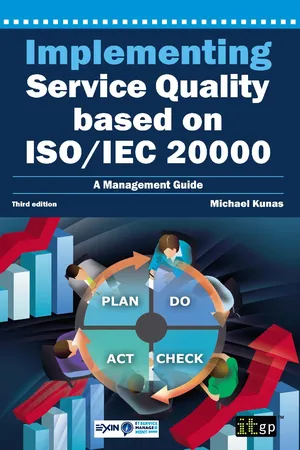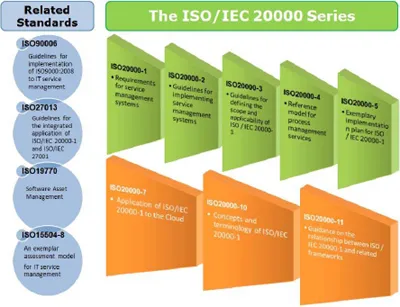![]()
CHAPTER 1: INTRODUCTION TO ISO/IEC 20000
The ISO/IEC 20000 Service Management Standard, first published by the organisations, ISO (International Organization for Standardization) and IEC (International Electrotechnical Commission) on 14 December 2005 and revised on 15 April 2011, is the internationally recognised standard in IT service management. The ISO/IEC 20000 series is based on the BS 15000 series developed by the British Standards Institution (BSI).
The goal of ISO/IEC 20000 is to establish a common reference standard for all companies which provide IT services for internal or external customers. Another goal is to promote a common terminology. Thus, the Standard has a significant contribution in the communication between service providers, suppliers and customers.
What are the benefits of implementing and certifying according to ISO/IEC 20000?
These will, of course, differ from organisation to organisation. However, the following list is a pretty good representation of the common results:
• Improved quality of service
• Increased business, and customer, confidence
• Improved reputation, consistency and interoperability
• Continuous improvement assured
• Optimised and controlled costs, through transparent and optimised structures
• Management and staff understand their roles and processes better
• Market advantage through a certificate issued by a recognised, independent, certification body
• Service management integrated into the overall business processes.
The integrated process approach from the Service Management Framework ITIL® is carried over to the Standard. This framework is positioned in a process model, which becomes part of the quality management system and is an important tool in communication with customers. The framework illustrates what processes control and continuously improves the service delivery.
Even though there is a link between ISO/IEC 20000 and ITIL, they are not aligned. The key differences are as follows:
• ISO/IEC 20000 requirements are completely independent of organisational structure or size, while ITIL includes advice and options for some aspects of organisational structure.
• In ISO/IEC 20000, service reporting is a separate process, while ITIL makes reference to service reports as part of the continual service improvement stage as well as part of every process.
• Service continuity and availability management have been combined in ISO/IEC 20000, while in ITIL, service continuity and availability management are separate processes.
• In ISO/IEC 20000, capacity management is presented as a single unit, while in ITIL three aspects are described: business, service and component capacity management.
• Financial management within ISO/IEC 20000 focuses purely on budgeting and accounting activities, while ITIL includes in-depth discussion on pricing and charging, which, of course, cannot be mandatory activities in any organisation.
• ITIL includes functional areas and 26 processes in life cycle stages while ISO/IEC 20000 focuses on the service management system (SMS) and 13 processes (no functions).
Figure 1: Relationship between ISO/IEC 20000 and ITIL
![]()
CHAPTER 2: SERVICE QUALITY AND ISO/IEC 20000
What is quality?
According to the American Society for Quality (ASQ), it is defined as follows: ‘A subjective term for which each person or sector has its own definition. In technical usage, quality can have two meanings:
1. The characteristics of a product or service that bear on its ability to satisfy stated or implied needs.
2. A product or service free of deficiencies.’
The Standard ISO9000 defines quality in the following way: ‘Degree to which a set of inherent characteristics fulfils requirements’. (Note: The term ‘quality’ can be used with adjectives, such as poor, good or excellent. ‘Inherent’, as opposed to ‘assigned’, means existing in something, especially as a permanent characteristic.)
The common element of all quality definitions is that the quality of a product or service refers to the perception of the degree to which the product or service meets the customer’s expectations.
Service quality is the first concept that must be considered for any organisation seeking to implement a service management system (SMS).
Quality in IT service management is one of the most important parts of the delivery of IT services. Consequently, service quality management plays an increasingly important role in the global IT service management environment.
Quality is achieved when the client is experiencing an added value from its IT business. The warranty of this added value in terms of availability, performance, continuity, and security in the daily operations, is as important as the technical support of applications and automated tasks.
![]()
CHAPTER 3: THE ISO/IEC 20000 FAMILY AND EMERGING RELATED STANDARDS
The Standard is organised in the following five parts:
1. Part 1: ISO/IEC 20000-1:2011 – Service Management System Requirements
2. Part 2: ISO/IEC 20000-2:2012 – Guidance on the Application of Service Management Systems
3. Part 3: ISO/IEC20000-3:2012 – Guidance on Scope Definition and Applicability of ISO/IEC 20000-1
4. Part 4: ISO/IEC TR 20000-4:2010 – Process Reference Model
5. Part 5: ISO/IEC TR 20000-5:2010 – Exemplar Implementation Plan for ISO/IEC 20000-1.
All five parts can be found on the IT Governance website, www.itgovernance.co.uk/catalog/47.
In the meantime, several other parts are currently under development within the ISO/IEC 20000 series, as well as other standards relating to the ISO/IEC 20000 series:
• ISO/IEC 20000-7 – Application of ISO/IEC 20000-1 to the Cloud
• ISO/IEC 20000-10 – Concepts and terminology of ISO/IEC 20000-1
• ISO/IEC 20000-11 – Guidance on the relationship between ISO/IEC 20000-1 and related frameworks
• ISO/IEC 90006 – Guidelines for the application of ISO9001:2008 to IT service management
• ISO/IEC 27013 – Guidelines on the integrated implementation of ISO/IEC 20000-1 and ISO/IEC 27001
• ISO/IEC CD 19770-3 – Software asset management – Part 3: Software entitlement tag
• ISO/IEC CD 19770-5 – Software asset management – Part 5: Overview and vocabulary
Other standards relating to the ISO/IEC 20000 series have already been published:
• ISO/IEC 15504-8 – An exemplar assessment model for IT service management
• ISO/IEC 19770-1:2012 – Software asset management – Part 1: Processes and tiered assessment of conformance
• ISO/IEC 19770-2:2009 – Software asset management – Part 2: Software identification tag.
Figure 2: ISO/IEC 20000 series and related frameworks
ISO/IEC 20000-1:2011
ISO/IEC 20000-1:2011 is the second edition of ISO/IEC 20000-1. It replaces the 2005 edition. The main differences are:
• Nine additional pages, including an expanded introduction, additional requirements, and new and updated definitions.
• A new title: ‘Service Management System – Requirements’ instead of Specification.
• Closer alignment to ISO 9001 Quality Management Systems – Requirements.
• Closer alignment to ISO/IEC 27001 Information Security Management – Requirements.
• Closer alignment to the ITIL best practice framework.
• Addition of many more definitions, updates to some definitions and removal of two definitions.
• Introduction of the term ‘Service Management System’ (SMS).
• Combining clauses 3 and 4 of the ISO/IEC 20000-1:2005 edition, to put all management system requirements into one clause.
• Clarification of the requirements for the governance of processes operated by other parties.
• Clarification of the requirements for defining the scope of the SMS.
• Clarification of the application of the Standard.
• Clarification that the PDCA methodology applies to the SMS, including the service management processes and the services.
• Introduction of new requirements for the design and transition of new, or changed, services.
• Nine clauses, instead of 10 – the release management clause has been removed and in...


